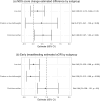Associations between text communication engagement and maternal-neonatal outcomes in the Mobile WACh NEO Trial
- PMID: 40773418
- PMCID: PMC12331090
- DOI: 10.1371/journal.pdig.0000968
Associations between text communication engagement and maternal-neonatal outcomes in the Mobile WACh NEO Trial
Abstract
Despite a global reduction in neonatal deaths in the last few decades, high neonatal mortality rates persist in low- to middle-income countries. Mobile health interventions offer a promising solution to promote early newborn care (ENC) practices and improve neonatal health. The Mobile WACh NEO randomized controlled trial evaluated the effect of a text messaging communication intervention on neonatal health outcomes in Kenya from 2020 to 2023. Perinatal participants received automated messages from enrollment at 28-36 weeks gestation until six weeks postpartum and could message with a study nurse. This secondary analysis aimed to characterize participant text engagement and examine associations between engagement and maternal-neonatal health outcomes. Among 2,470 intervention participants retained through follow-up, median time in the intervention was 14 weeks. Participants received a median of 58 automated messages (average 0.58 per day), sent a median of 24 messages (average 0.25 per day), and received a median of 14 nurse responses (average 0.14 per day). Younger, more educated, unmarried, unemployed, and first-time mothers sent more messages, while those who had a lower social support score at baseline messaged less. Increased participant messaging was associated with greater increase in neonatal danger sign knowledge from baseline to six-week follow-up (Adj Est: 0.39; 95% CI: 0.09-0.68) and lower odds of early initiation of breastfeeding (aOR: 0.62; 95% CI: 0.45-0.86). Our findings contribute to the understanding of who can benefit from mobile health programs and how these interventions might impact behaviors and outcomes.
Copyright: © 2025 Peng et al. This is an open access article distributed under the terms of the Creative Commons Attribution License, which permits unrestricted use, distribution, and reproduction in any medium, provided the original author and source are credited.
Conflict of interest statement
The authors have declared that no competing interests exist.
Figures




References
-
- Sharrow D, Hug L, You D, Alkema L, Black R, Cousens S, et al. Global, regional, and national trends in under-5 mortality between 1990 and 2019 with scenario-based projections until 2030: a systematic analysis by the UN Inter-agency Group for Child Mortality Estimation. Lancet Glob Health. 2022;10(2):e195–206. doi: 10.1016/S2214-109X(21)00515-5 - DOI - PMC - PubMed
-
- World Health Organization. Targets of Sustainable Development Goal 3 [Internet]. Geneva: WHO; [cited 2024 Nov 6]. Available from: https://www.who.int/europe/about-us/our-work/sustainable-development-goa...
-
- Akseer N, Lawn JE, Keenan W, Konstantopoulos A, Cooper P, Ismail Z, et al. Ending preventable newborn deaths in a generation. Int J Gynecol Obstet. 2015;131(S1):S43-8. - PubMed
-
- Ahmed KY, Thapa S, Hassen TA, Tegegne TK, Dadi AF, Odo DB, et al. Population modifiable risk factors associated with neonatal mortality in 35 sub-Saharan Africa countries: analysis of data from demographic and health surveys. EClinicalMedicine. 2024;73:102682. doi: 10.1016/j.eclinm.2024.102682 - DOI - PMC - PubMed
Grants and funding
LinkOut - more resources
Full Text Sources
Research Materials
